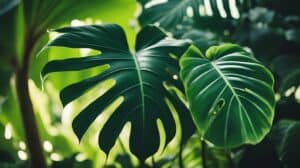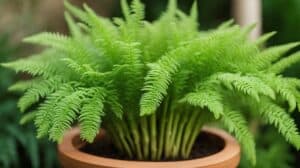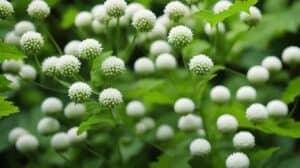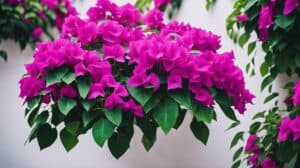The Ponytail Palm, also known as Beaucarnea Recurvata, is a popular indoor plant known for its unique appearance and easy-to-care-for nature.
Despite its name, the Ponytail Palm is not a true palm tree but rather a member of the agave family.
Native to Mexico, the plant is now widely grown in homes and offices around the world.

In this article, you will discover the secrets to thriving Ponytail Palm care, including tips on watering, lighting, and soil.
Whether you are a seasoned plant parent or a beginner, this guide will provide you with all the information you need to keep your Ponytail Palm healthy and happy.
So, let’s get started and explore the wonderful world of Beaucarnea Recurvata!
Getting to Know Your Ponytail Palm

Botanical Profile
The Ponytail Palm (Beaucarnea recurvata) is a unique and fascinating plant that is native to Mexico.
It is also known as the Elephant Foot Tree, Bottle Palm, or Nolina Palm. Despite its name, it is not a true palm, but rather a member of the Agave family.
The plant has a distinctive appearance, with a thick, swollen base that tapers to a slender trunk.
The trunk is topped by a rosette of long, slender leaves that resemble a ponytail, hence the name.
The leaves can grow up to 3 feet long and are a bright green color.
Growth Habits
The Ponytail Palm is a slow-growing plant that can eventually reach heights of up to 30 feet in its native habitat.
However, when grown indoors, it typically reaches a height of 3-6 feet.
It is a hardy plant that can tolerate a wide range of growing conditions, including low light, low humidity, and infrequent watering.
One of the most interesting things about the Ponytail Palm is its ability to store water in its swollen base.
This adaptation allows it to survive in arid environments with little rainfall.
As a result, it is important not to overwater the plant, as this can lead to root rot.
In summary, the Ponytail Palm is a unique and fascinating plant that is easy to care for and can add a touch of exotic beauty to any indoor space.
By understanding its botanical profile and growth habits, you can provide the best possible care for your plant and help it thrive.
Optimal Growing Conditions
Light Requirements
The Ponytail Palm requires bright, indirect sunlight for optimal growth.
It can also tolerate some direct sunlight, but too much can cause the leaves to burn.
If the plant is not receiving enough light, its growth may slow down, and the leaves may become pale or yellow.
To ensure that the plant receives enough light, it is recommended to place it near a south-facing window or to use a grow light.
Temperature and Humidity
The Ponytail Palm prefers warm temperatures between 65-80°F (18-27°C).
It can tolerate lower temperatures, but it is best to avoid exposing it to temperatures below 50°F (10°C) for extended periods.
The plant can also tolerate low humidity levels, but it may benefit from occasional misting or placement on a pebble tray to increase humidity.
Watering Schedule
The Ponytail Palm is a drought-tolerant plant and prefers to dry out between waterings.
It is recommended to water the plant thoroughly and then allow the soil to dry out before watering again.
Overwatering can lead to root rot, so it is important to ensure that the pot has proper drainage.
In the winter months, the plant may require less frequent watering.
Soil and Potting Mix
The Ponytail Palm prefers well-draining soil and does not require frequent repotting.
It is recommended to use a cactus or succulent potting mix, or to mix regular potting soil with sand or perlite to improve drainage.
When repotting, it is important to choose a pot that is only slightly larger than the current one to prevent overwatering.
Maintenance and Care

Fertilizing Your Ponytail Palm
Fertilizing your ponytail palm is essential to keep it healthy and thriving.
During the growing season, which is from spring to fall, you should fertilize your plant every two to three weeks.
Use a balanced liquid fertilizer, diluted to half the recommended strength, and apply it to the soil.
Do not fertilize during the winter months as your plant is dormant during this time.
Pruning and Cleaning
Ponytail palms do not require much pruning, but you can remove any yellow or brown leaves to keep your plant looking neat.
You should also clean the leaves occasionally to remove any dust or debris. Use a damp cloth or sponge to wipe the leaves gently.
Do not use any chemical cleaners as they can damage the plant.
Repotting Tips
Ponytail palms do not need to be repotted frequently as they prefer to be slightly root-bound.
However, if your plant has outgrown its current pot or the soil has become compacted, it may be time to repot.
Choose a pot that is only slightly larger than the current one, and use a well-draining potting mix.
Water your plant thoroughly after repotting and avoid fertilizing for the first few months.
By following these maintenance and care tips, you can ensure that your ponytail palm stays healthy and beautiful for years to come.
Troubleshooting Common Issues

Pest Infestations
Ponytail Palms are generally resistant to pests, but sometimes they can still be affected by spider mites, mealybugs, or scale insects.
These pests can cause discoloration, stunted growth, and leaf drop. To prevent pest infestations, it is important to keep the plant clean and dry.
If you notice any signs of pest infestation, you can use a mild insecticidal soap to treat the plant.
Be sure to follow the instructions on the label carefully.
Diseases and Disorders
Ponytail Palms are susceptible to root rot if they are overwatered or if they are planted in soil that does not drain well.
This can cause the leaves to turn yellow and wilt. To prevent root rot, make sure the soil is well-draining and allow the soil to dry out between waterings.
If you suspect root rot, you can try repotting the plant in fresh, well-draining soil.
In addition, Ponytail Palms can also be affected by leaf spot, which can cause brown spots on the leaves. This can be caused by overwatering or high humidity.
To prevent leaf spot, make sure the plant is not overwatered and that the humidity levels are low.
Leaf Browning and Drop
Ponytail Palms may experience leaf browning and drop if they are exposed to cold temperatures or if they are underwatered.
In addition, if the plant is placed in a location with too much direct sunlight, the leaves may become scorched and brown.
To prevent leaf browning and drop, make sure the plant is placed in a location with bright, indirect sunlight and that it is watered regularly.
If the leaves have already turned brown, you can prune them off to encourage new growth.
Frequently Asked Questions

What are the ideal lighting conditions for a Ponytail Palm indoors?
Ponytail Palms prefer bright, indirect light. They can also tolerate some direct sunlight, but too much can scorch their leaves.
If your indoor space doesn’t receive a lot of natural light, you can supplement with artificial light, such as fluorescent or LED grow lights.
How often should I water my indoor Ponytail Palm?
Ponytail Palms are drought-tolerant and prefer to dry out between waterings.
Water your plant thoroughly, allowing the soil to dry out completely before watering again.
In general, you should water your Ponytail Palm every 2-3 weeks, but this can vary depending on the humidity and temperature of your home.
What is the best type of soil for potting a Ponytail Palm?
Ponytail Palms prefer well-draining soil that is rich in organic matter. A mixture of potting soil, sand, and perlite works well.
Avoid using heavy soils that retain too much moisture, as this can lead to root rot.
When and how should I fertilize my Ponytail Palm?
Ponytail Palms don’t require a lot of fertilizer, but you can give them a boost during the growing season (spring and summer) with a balanced, water-soluble fertilizer.
Dilute the fertilizer to half strength and apply every 2-4 weeks.
How can I tell if my Ponytail Palm needs to be repotted?
Ponytail Palms are slow-growing and can remain in the same pot for several years.
However, if you notice that the roots are growing out of the drainage holes or the plant is becoming top-heavy, it may be time to repot.
Choose a pot that is only slightly larger than the current one and use fresh soil.
What should I do if the tips of my Ponytail Palm are turning brown?
Brown tips on the leaves of a Ponytail Palm can be a sign of underwatering, overwatering, or dry air.
Check the soil moisture and adjust your watering schedule as needed.
You can also increase the humidity around the plant by misting the leaves or placing a tray of water nearby.
Trim off any brown tips with clean scissors to promote new growth.














